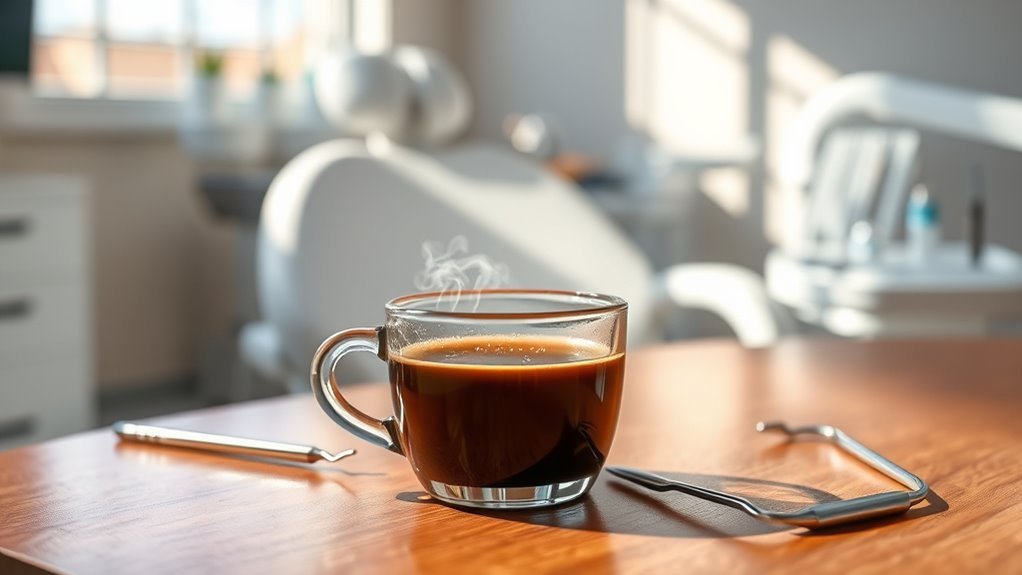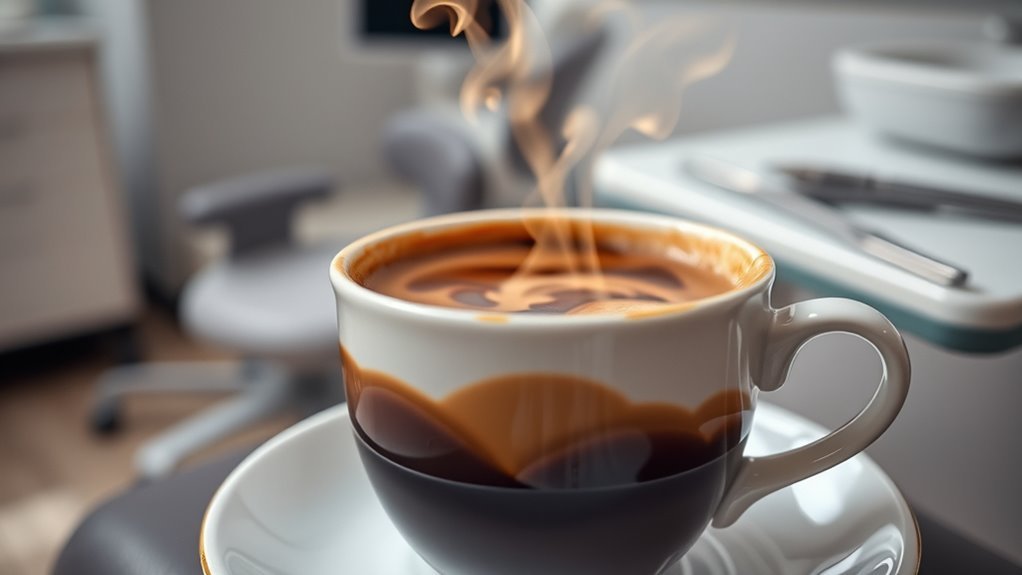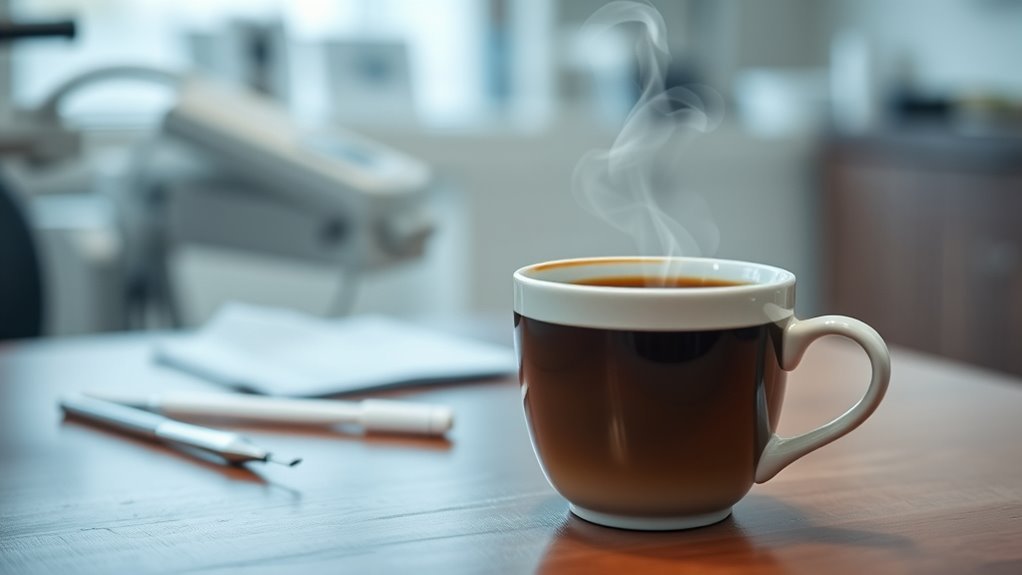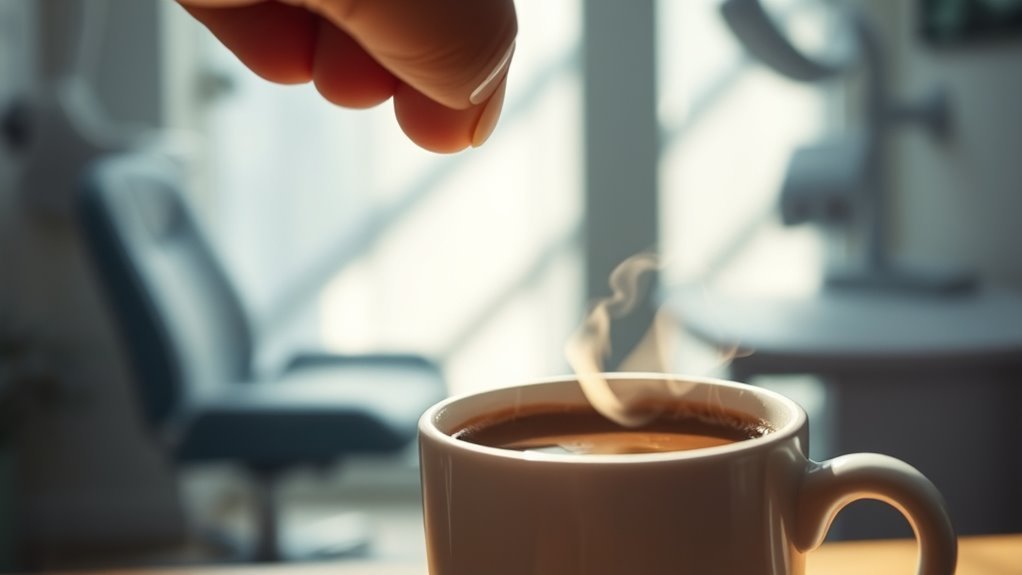Can You Drink Coffee After Getting a Filling
After getting a filling, you should be cautious with coffee. Wait until the numbness fades to avoid burns. It’s best to hold off on hot coffee for at least 24 hours, as extreme temperatures can cause sensitivity. Also, be mindful of caffeine’s potential to increase anxiety or discomfort. If you feel any sensitivity or pain, consider avoiding coffee altogether. There are more tips on how to care for your filling to guarantee a smooth recovery.
Understanding Dental Fillings and Their Process

When you need a dental filling, it’s vital to understand the procedure involved, as it can impact your post-treatment care. The process typically begins with your dentist evaluating the cavity’s extent. They’ll then select appropriate filling materials, which could include composite resin, amalgam, or glass ionomer, based on factors like location and your preferences. After numbing the area, your dentist will remove the decayed tissue, clean the cavity, and place the filling material. Proper bonding and shaping guarantee the filling fits well with your natural tooth structure. Understanding these dental procedures helps you appreciate the importance of proper care, as it influences the longevity of your filling and overall oral health. Being informed empowers you to make better choices moving forward.
Immediate Aftercare Tips Post-Filling
After undergoing the filling procedure, it’s important to follow specific aftercare tips to guarantee a smooth recovery and the longevity of your filling. First, avoid eating until the numbness wears off to prevent biting your cheek or tongue. For pain management, over-the-counter pain relievers can help alleviate discomfort as needed. Stick to soft foods for the first 24 hours, and try to avoid sticky or hard items that could dislodge the filling. Maintain good oral hygiene by gently brushing and flossing, but be cautious around the filled area. Finally, stay hydrated, but limit hot beverages until your dentist advises it’s safe. Following these post filling care guidelines will guarantee your filling remains effective and your mouth heals properly.
The Impact of Temperature on Healing

While your mouth is healing after a filling, the temperature of the foods and beverages you consume can greatly impact your recovery. Extreme temperatures, whether hot or cold, can interfere with temperature regulation in the affected area and may exacerbate sensitivity. During the healing process, it’s best to opt for lukewarm or room-temperature items to avoid discomfort and promote better healing. Consuming very hot or icy drinks can lead to unnecessary pain and delay your recovery. By being mindful of the temperature of what you eat and drink, you’re supporting your body’s natural healing mechanisms. This conscious approach allows you to enjoy your meals without compromising your dental health as you recover from your filling.
Caffeine and Its Effects on Your Body
Caffeine, a natural stimulant found in coffee and many other beverages, can greatly affect your body, particularly when you’re recovering from dental work like a filling. When you consume caffeine, your body undergoes caffeine metabolism, which can influence how you feel and heal. While caffeine can provide health benefits, such as increased alertness and improved mood, it may also lead to heightened anxiety or discomfort, especially if you’re already sensitive post-procedure. It’s crucial to reflect on how your body reacts to caffeine during recovery. Balancing your caffeine intake could help you enjoy its benefits without compromising your healing process. Ultimately, being mindful of how caffeine interacts with your recovery is important for maintaining your overall well-being.
Recommendations for Drinking Coffee After a Filling

After getting a filling, it’s important to wait until the numbness from anesthesia wears off before drinking coffee to avoid accidental burns. Additionally, consider the temperature of your beverage, as your newly filled tooth may be sensitive to extremes. Opting for low-acidity coffee can also help minimize discomfort during your recovery.
Wait for Numbness to Fade
Once the numbness from your dental filling begins to subside, it’s important to exercise caution before indulging in your favorite cup of coffee. The numbness duration can vary, but it typically lasts a few hours. During this time, you might unintentionally bite your cheek or tongue if you’re not careful. As you wait for the sensation to return, focus on pain management; over-the-counter pain relievers can help if you experience discomfort. Once the numbness has completely faded and you regain full control over your mouth, you can enjoy coffee again. Remember, waiting guarantees you won’t inadvertently harm yourself while sipping that warm beverage. Prioritizing your safety will ultimately enhance your coffee experience post-filling.
Temperature Sensitivity Considerations
Although it might be tempting to sip on your favorite hot coffee right away, it’s essential to contemplate how temperature can affect your recently filled tooth. After getting a filling, you may experience some degree of temperature sensitivity, which can lead to dental discomfort when consuming hot beverages. It’s advisable to wait at least 24 hours before indulging in hot coffee, allowing your tooth to adjust and the filling to set properly. This waiting period can help minimize the risk of irritation and pain. If you find that your tooth remains sensitive beyond this initial period, consult your dentist for further guidance. Prioritizing your comfort will ultimately enhance your post-filling experience.
Choose Low-Acidity Options
If you’re enthusiastic to enjoy a cup of coffee following your dental filling, opting for low-acidity options can be beneficial for your tooth’s comfort. Low acid coffee can minimize sensitivity and irritation, making your experience more enjoyable. Here are some great low-acidity choices and alternatives:
| Low-Acidity Coffee | Coffee Alternatives | Brands to evaluate |
|---|---|---|
| Cold Brew | Herbal Tea | Lifeboost Coffee |
| Arabica Beans | Decaf Coffee | Puroast Coffee |
| Dark Roasts | Chicory Coffee | Kicking Horse Coffee |
| Espresso (in moderation) | Almond Milk Coffee | Healthwise Coffee |
Listening to Your Body: When to Avoid Coffee

How can you tell when it’s time to steer clear of coffee after a dental filling? Listening to your body is essential. Pay attention to specific cues like sensitivity, pain, or discomfort in the filled tooth. If you experience these signals, it’s wise to hold off on coffee, especially if it’s hot or acidic. Similarly, if you notice increased anxiety or restlessness after consuming caffeine, consider taking a break. Your body’s signals are your best guide; they can indicate whether it’s safe to indulge or if you should wait a bit longer. Ultimately, prioritizing your comfort will help you enjoy your coffee without compromising your dental health. Trust your instincts for the best results.
Frequently Asked Questions
How Long Does a Dental Filling Last?
You might be surprised to learn that a dental filling’s longevity can vary considerably. Typically, fillings last anywhere from five to fifteen years, depending on the material used and your oral hygiene habits. To maximize filling maintenance, you should brush and floss regularly, and visit your dentist for check-ups. By taking care of your teeth, you can enjoy the freedom and confidence that comes with a healthy smile for years to come.
Can I Eat After Getting a Filling?
After getting a filling, it’s important to wait a bit before eating. Your dentist might recommend holding off for at least an hour, especially if local anesthesia was used. This helps guarantee proper dental care and allows your filling to set effectively. When you do eat, opt for soft foods to maintain good oral hygiene and avoid discomfort. Listen to your body and prioritize your dental health during the recovery process.
What Materials Are Used for Dental Fillings?
When it comes to dental fillings, think of them as your teeth’s armor against decay. You’ve got options: composite fillings, which blend seamlessly with your natural teeth for a discreet look, and amalgam fillings, made from a mix of metals for durability. Each material has its strengths, so you can choose what fits your needs best. Your dentist can guide you in selecting the right filling for a long-lasting solution to tooth decay.
Are There Side Effects From Dental Fillings?
Yes, there can be side effects from dental fillings. You might experience sensitivity issues, especially to hot or cold temperatures, which usually subsides over time. Some patients also report mild discomfort or pain, necessitating effective pain management strategies. If you find the sensitivity or pain persists, it’s important to consult your dentist. They can assess your situation and make sure your filling is functioning correctly, allowing you to enjoy your daily activities without worry.
How Do I Know if My Filling Is Failing?
Did you know that nearly 30% of dental fillings can fail within ten years? If you’re concerned about a failing filling, watch for symptoms like sensitivity to hot or cold, pain when biting, or visible cracks. Regular filling maintenance is essential; schedule check-ups to catch issues early. If you experience any of these filling symptoms, it’s best to consult your dentist. They’ll help guarantee your dental health remains a priority.






